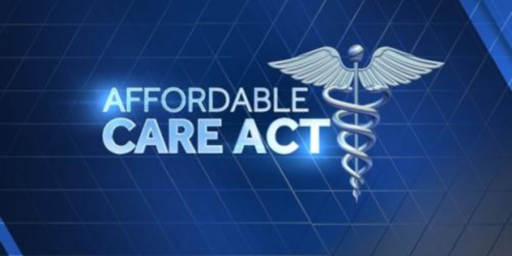Affordable Care Act Making Health Insurance Less Affordable
The law of unintended consequences strikes again.
Contrary to its name and the arguments made by its proponents both when the bill was being debated in 2009 and 2010 and in the time since then, the President’s signature piece of legislation appears to be making health insurance more expensive for a wide swath of the population:
Health insurance premiums are showing the sharpest increases perhaps ever according to a survey of brokers who sell coverage in the individual and small group market. Morgan Stanley’s healthcare analysts conducted the proprietary survey of 148 brokers. The April survey shows the largest acceleration in small and individual group rates in any of the 12 prior quarterly periods when it has been conducted.
The average increases are in excess of 11% in the small group market and 12% in the individual market. Some state show increases 10 to 50 times that amount. The analysts conclude that the “increases are largely due to changes under the ACA.”
The analysts conducting the survey attribute the rate increases largely to a combination of four factors set in motion by Obamacare: Commercial underwriting restrictions, the age bands that don’t allow insurers to vary premiums between young and old beneficiaries based on the actual costs of providing the coverage, the new excise taxes being levied on insurance plans, and new benefit designs.
The prior survey conducted in January also showed rates rising during the fall of 2013, but the new increases will come on top of those hikes and are even sharper. That prior survey of 131 brokers found that December 2013 rates were rising in excess of 6% in the small group market, and 9% in the individual market.
The hikes in the small group market, on average, have been largest for the Blues plans, which reported average rate increases of almost 16% year-over-year for renewing contracts. In the individual market, the publicly traded health plans had higher increases than the blues, at an average of more than 11%, and private and not-for-profit plans had the highest average increases overall at 13%.
Defenders of the President’s health care law, of course, will counter this argument by pointing out that these increases don’t impact the majority of Americans, who continue to receive their health insurance through employer-supported plans of one type or another. While this is correct, it ignores several factors which suggest that these premium increases could become a much more serious issue in the future. First of all, even if the people impacted by these premium increases represent a minority of Americans, they are still a sizable portion of the population and the impact that they are feeling is going to have an economic effect of some kind. Second, it’s quite probably the case that the premium increases we’re seeing in the individual and small group markets will start showing up in the employer provided market as well. When that happens, it will increase the burden on employers, cut into profits, and could potentially slow down hiring. Finally, many people now covered by employer provided plans are likely to find themselves having to shop for insurance in the exchanges themselves in the future. When that happens, they’re going to experience the same sticker shock that many of their fellow Americans have already had to deal with.
Increased premiums are not the only financial impact that many Americans are seeing from the “Affordable Care Act,” of course. When they went shopping for policies on the exchanges between last October and the end of March, many Americans found that the only choices available to them were plans with significantly hire deductibles that they were faced with in the past. This means that far more Americans will be paying for health care needs out of pocket than they used to in the past But, of course, nobody told us that might happen when the law was being debated, and the Vice-President was calling it a “big f**king deal.” Reality is turning out to be far different from the selling points.






Sounds awfully preliminary to me, Doug.
If the dust settles and it’s clear that the small group and individual markets have seen large increases, that’s a fair criticism of the law (as taming the insanity of the individual market was one of the key things it was intended to do). I just don’t buy it yet.
Also, too: we’ll see about your arguments about the rest of the market. So far, the indications are that medical care cost growth has slowed, and overall medical insurance prices haven’t increased dramatically.
Given the source, and your ideological priors, I think there’s a very good chance this whole post was built on cherry-picking to get a pre-determined conclusion.
Time will tell.
One…I can only tell you that our firm was seeing increases of 25-30% annually before. Less now. That’s what’s meant by bending the curve down.
Two…If you take a bunch of people off policies that are essentially scams and would never pay off on anything…and put them on real policies that will pay off as intended…then of course costs will rise. Because they actually have insurance now.
Three…it’s increasing difficult to take your Obamacare posts seriously…given your ODS track record.
@Rob in CT:
Let me amend this a bit.
I honestly think we need years of experience to know anything with even a shred of certainty. By this measure, crowing about enrollment numbers or the past few years of relatively slow cost growth is premature as well.
It may not be terribly satisfying, but we just can’t know yet if our fancy new Rube Goldberg machine is going to work well, ok, or badly.
This “survey of insurance brokers” appears to be in conflict with all other available data. For instance, the survey gave a 90% increase on premiums in New Hampshire. Well,
And why would we need a broker survey to assess premiums? This is all very fishy.
By the way, interesting article on Vermont’s efforts over at Vox (which so far looks like a solid effort):
http://www.vox.com/2014/4/9/5557696/forget-obamacare-vermont-wants-to-bring-single-payer-to-america
Something that jumped out at me, because (to be candid) it fits right with my expectations:
I’ve long wondered about this. Just about every time I’ve been to a doctor, dealing with insurance seems to be the major hassle. There’s nothing inherently crazy about isnurance, but we have so many different insurers and networks and such that it becomes labor-intensive.
Still, VT has a major challenge here (estimated $2B/yr to pay for single payer, when current *total* revenues are $2.6B/yr. I don’t know the net cost – people will obviously pay more in taxes but no premiums), and it’ll be interesting to follow their progress.
@C. Clavin: I think if Obama cured cancer, Doug’s first post would be “Obama causes thousands of healthcare workers to lose jobs”. We get it, you hate people getting healthcare because not every single thing is perfect (like it was before, right?) but you still have nothing better to offer. Aren’t you tired of this?
@Rob in CT:
Well, of course. Just as with SS and Medicare it will be bumpy for some time, we won’t know for years, and changes will inevitably be made along the way.
http://blogs.reuters.com/great-debate/2013/10/28/what-about-social-securitys-rollout/
But I really think all that crowing was in response to naysayers…like Doug…predicting the CBO estimate of 7M enrollees wouldn’t be reached.
Gosh, another passive-aggressive attack on the ACA from Doug. And when it is dismantled by 100 responders over a couple of days, Doug will ignore all of that and then post another factually challenged smear.
If Doug thinks poor people should die miserably, then I wish he’d just come out and say it like the rest of the Republican party. The intellectual dishonesty of what he does is here is just sad.
I think that’s true of anyone trying to sell us on something, including the folks that would like to sell the idea that there’s nothing but downside when it comes to the ACA.
I opposed the ACA because I couldn’t see any reason why insurance companies should be involved in healthcare sucking 20+ percent out of the healthcare budget. Medicare for all and yes there should be “death panels”. Spending 100s of thousands of dollars to keep a 90 year old alive for an additional 3 months makes no sense at all.
Less affordable is exactly what health insurance premiums were becoming prior to the passage of ACA. From the mid-1990s to 2009 the average annual increase in the cost of health insurance premiums was over 3 times the rate of inflation.
Well, it make a lot of sense if you are the one profiting from it. “Suck them dry, then let them die” is a big component of the system.
let’s see if that shows up in the CPI on Monday…so far, YOY increases for insurance have stayed under 2%
@anjin-san: Yes, that’s part of the problem. I refused to go along with it and signed my 90 year old mother with home hospice and was her 24/7 caregiver for several months saving the system a bunch of money.
@ Ron Beasley
My dad’s oncologist seemed to be flat out angry when dad declined treatment for what they told him (correctly) was absolutely terminal cancer. Even though an all-out course of chemo would buy him six extra months tops.
@anjin-san: Yes indeed, I got into a major argument with my mother’s doctor when I chose home hospice for her. She had over 90 years and 89 of those were pretty damned good. Who can ask for more?
Higher deductibles, hmmm? My self-employed, uninsured husband with some relatively minor pre-existing conditions saw his deductible go from 100% of what the provider felt like charging to $10,000 and $10 co-pays for office visits. He was in the hospital for 26 hours a few years back (when he was still insured through his then employer) and the bill for everything was $29,000. The insurance company negotiated a much lower payout of course. We went 3 years with that threat hanging over our heads. From my end the unintended consequences look an awful lot like a better night’s sleep.
From inside the industry, I think it is clear that, in the (relatively small) individual market, there are indeed winners and losers. The losers are healthier, older and wealthier. The winners are pretty much everyone else. Comparing simliar plan to similiar plan, there are drops in price for many and increases for the losers noted above – but the average change is around or below what it has historcally been over the last few years.
Of course, if any of those “losers” get sick or develop a chronic condition, they magically transform to “not-losers”.
Another group that claims to be “losers” are those who wanted to be risk-takers, either going without insurance or with only catastrophic or other substandard coverage, but are not complying with the mandate. They are “losers” in the sense that they aren’t allowed anymore to transfer their risk to hospitals and the population at large.
I should also note that none of the above was in any way unintended or unforeseen. We’ve known about it since before PPACA was passed.
Also, be wary of brokers’ take on the law. They are one of the predestined “losers” as individuals and (soon) small companies can now bypass them and compare and buy directly from the exchange.
http://talkingpointsmemo.com/dc/rand-obamacare-study-employer-insurance
After this brilliant post the other day, I’m not sure Doug should be allowed to write about the ACA anymore.
@wr: it’s like ringing someone’s doorbell and then running away, isn’t it?
This might be worth reading, Doug.
http://www.vox.com/2014/4/9/5597600/the-best-evidence-we-have-that-obamacare-is-working
Who writes this stuff? Mathematically it doesn’t make sense. If the average increase is 11% and some of those plans show 110-550% increase, then some plans probably show a decrease. Then I would assume the magic of the market would demonstrate its will by having the lower priced plans hugely outsell the overpriced ones. Of course, this is assuming that the author meant to write what he wrote.
I agree- the numbers are not very clear- that said- insurance rates were going up 10%+ a year pre ACA so the impact of ACA is unclear. No doubt some people are paying more for better coverage.
I teach medical students how to critically read the literature. This piece has two large red flags and should be treated with skepticism. If you go back to the original that Doug cites (and this appears to be the original that everyone is citing) it does not link to the original study. it is a report of a report with no way to access the original. Someone with their own biases (we all have them), has culled out what they think is important, without telling us how they chose their numbers or how the originals were derived. Also, all numbers are cited as percentages. We are given no raw numbers. For the state that saw an increase of 588%, what was the starting number? That would tell us a lot. I suspect that there is a reason those were not reported.
There could be some truth here, we just dont know. I can see why a blog writer, uninformed on health care and policy, might cite this, but this is the kind of thing we should all ignore.
Steve
Of course premiums are going to go up without a Public Option. There is nothing to compete against the insurance companies except themselves and if you think that’s really market competition your deluding yourself. The ACA without a Public Option essentially threw everyone to the wolves and then mandated that we had to feed the wolves or be fined.
@mantis:
Not surprising. Forbes’ coverage of the ACA has been entirely BS or hugely misleading RW-clickbait for the last couple of years. Avik Roy & Scott Gottlieb keep churning it out and their target audience keeps falling for it.
A sample of Gottlieb’s ‘Recent Posts’:
Nowhere did any of the supporters of the ACA say that it would lower costs for EVERYONE.(It didn’t promise everyone their own personal rainbow either). The point of the ACA was that it would extend health insurance coverage to everyone so that everyone-including the previously uninsured-could afford health care.
I notice Doug has yet to mention that millions of formerly uninsured people now have insurance coverage and now have access to health care. Does that really mean nothing to you, Doug? Do you have no empathy at all for those people? (Serious question).
Maybe you just say bluntly that you are in principle opposed to the government helping those poorer and less fortunate than yourself getting access to health care. State your position, own it, and be up front about it. Let your freak flag fly.
@Jeremy R:
Yeah, Gottlieb is an AEI flack. This isn’t reporting. It’s spinning, and knowing AEI, probably outright lying about a study the details of which are unknown. Who are the brokers? What policies do they sell and at what volumes? What questions were they asked? Are they reporting actual prices or offering predictions? Why don’t their numbers match with any other data we are seeing? We know the answers to none of these questions.
Let’s also not forget that these are brokers of individual policies outside the exchanges and not directly from insurance companies. If I were to hazard a guess, I’d say there are shenanigans going on in that niche, which has been made much smaller (and less profitable) by the presence of the exchanges.
@beth: Some reasons for increased health costs over the last several years have over-medicated, over doctored , over tested, and over specialized medical care. The rise of cheap HMO’s back in the 80’s encouraged people to go to the doctor for anything and everything. Costs soared and the HMO’s went out. Also the weird pricing at hospitals where a box of drink straws costs $300. Lots of blame to go around related to costs, including unnecessary and outrageous lawsuits.
Ah, the usual response to ACA numbers. Good numbers we should accept unquestionably. Bad numbers we’ll have to “wait and see”.
Also, nice selective quoting of the RAND study by TPM. They ignore that the RAND study shows a lot fewer enrollees through the exchanges and Medicaid and individual markets than Obama is claiming right now (although all have significant uncertainties). But since those numbers would be bad for ACA, we’ll just have to consider them preliminary and wait and see what happens.
Frankly, I don’t see how insurance rates are not going to rise quite substantially. If you insure more people, especially people who cost a lot to insure, that’s going to raise rates. That’s what happened in Massachusetts after Romneycare. I see no reason why it shouldn’t happen after Obamacare. Subsidies might hide some of that but you will still see significant increases as utilization goes up (yes, including emergency room visits, according to Annals of Emergency Medicine).
@Hal_10000:
And what was happening to rates before Obamacare?
Oh…rising more substantially? Got it.
@Hal_10000:
Hey, I’m all for acknowledging the bad numbers. But can we give a little shout out to the GOOD numbers? If you read the OP you would never guess that the Administration hit its target of 7M enrollees, that 9.5M people are newly insured, and that the percentage of uninsured people has fallen since the introduction of the ACA. All we’ve gotten is mean spirited carping about possible bad effects of the ACA. Are premiums going to go up next year? Frankly we won’t know until the data comes in on who enrolled. But clearly the ACA seems to be hitting its targets so there is no reason to think the ACA will cause any unusual rise in premiums.
If there is any celebration of good numbers it’s because it’s to counteract the drumbeat of OBAMACARE IS A DISASTER!!!! coming constantly from the right wing BS machine- which Doug seems to be imitating.
I acknowledged those numbers in the last Obamacare discussion. I don’t think anyone questioned whether expanding Medicaid, for example, which is at least half of the gain, would insure more people. They questioned whether it was a good idea or an efficient way of approaching the problem. Remember that current projections are that spending on these thing will eventually be over $200 billion a year.
What I do object to is people grabbing every bit of positive news and ignoring all the negative news (just as I object to people doing the opposite). I also remember that we were told that insuring people would cut healthcare costs and that people like me, who pointed out that it would increase them, were mocked for saying so.
@Hal_10000:
There’s no question that expanding Medicaid is the most cost effective way to expand health care coverage. The spending totals in the future are irrelevant. The lower enrollment figures from the RAND study are due to not covering the entire open enrollment period.
Insuring more people doesn’t mean that rates should increase, unless those people were excluded from the market before. Requiring the insurance actually meet reasonable standards will increase costs though.
The RAND study goes through March 28. I am dubious that three million people signed up on those last few days. Medicaid is a cost-effective way to expand coverage, if expanding coverage cheaply is your goal. If your goal is improving health outcomes, it’s not. Medicaid is terrible insurance. Many doctors won’t take it and Medicaid-intense hospitals are the worst in the country. As David Goldhill pointed out years ago, you’d be better off replacing it with high deductible insurance and giving every member a voucher for the deductible.
Spending totals in the future are irrelevant? What happened to all that stuff about bending the cost curve?
Insuring more people does mean rates will increase because utilization increases (including ER visits). This is exactly what happened in Massachusetts after Romneycare. if being insured doesn’t mean people get more healthcare, what is the point in insuring them? We were told this was necessary because people were dying from not being insured. Well, dying is cheap. Not dying is expensive. If getting more people insured and creating better health outcomes is your goal — and it should be — you can’t pretend that it’s not going to cost anything. It’s going to cost a lot.
@Hal_10000:
Medicaid is easily better than the alternative, nothing. Future spending for Obamacare doesn’t really have anything to do with bending the cost curve. The RAND study ended on the 28th, but much of it was completed before that date. No one has ever claimed that this doesn’t cost anything.
@Hal_10000:
And you can’t pretend that medical prices, which are negotiated by insurance companies based on the amount of customers they have in their pool, won’t go down since hijinks like hospital chargemaster lists will be harder to pull off with greater buying power.
FactCheck.org is a little less kind to the survey.